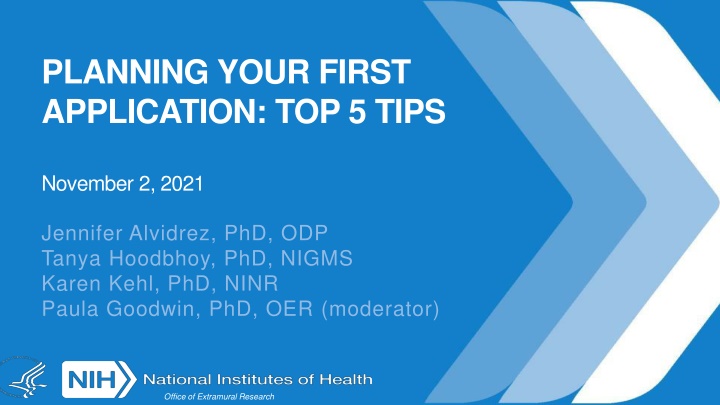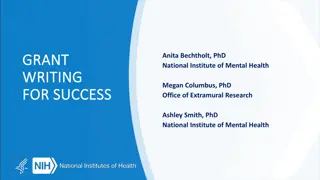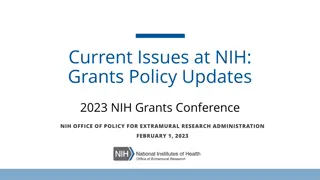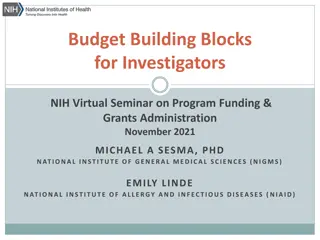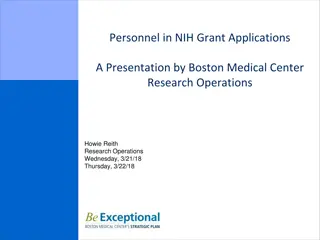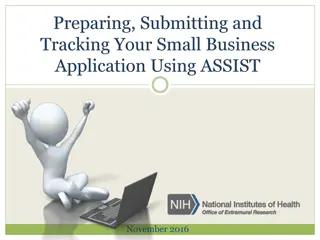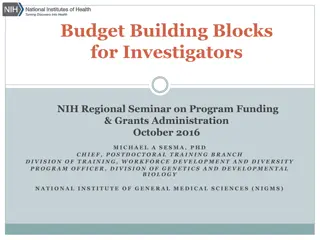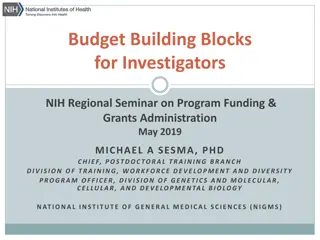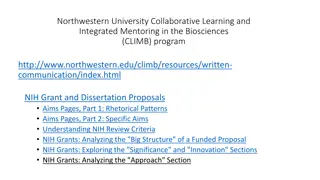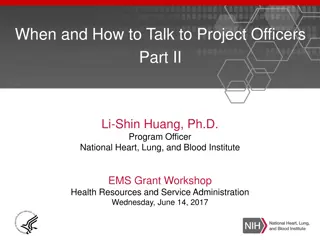Essential Tips for NIH Grant Application Success
Practical tips for planning your first NIH grant application, including finding the right NIH institute or center, contacting program officials, understanding the funding opportunity announcement, and seeking feedback on your application draft.
Download Presentation

Please find below an Image/Link to download the presentation.
The content on the website is provided AS IS for your information and personal use only. It may not be sold, licensed, or shared on other websites without obtaining consent from the author.If you encounter any issues during the download, it is possible that the publisher has removed the file from their server.
You are allowed to download the files provided on this website for personal or commercial use, subject to the condition that they are used lawfully. All files are the property of their respective owners.
The content on the website is provided AS IS for your information and personal use only. It may not be sold, licensed, or shared on other websites without obtaining consent from the author.
E N D
Presentation Transcript
PLANNING YOUR FIRST APPLICATION: TOP 5 TIPS November 2, 2021 Jennifer Alvidrez, PhD, ODP Tanya Hoodbhoy, PhD, NIGMS Karen Kehl, PhD, NINR Paula Goodwin, PhD, OER (moderator) Office of Extramural Research
TIP #1: FIND AN NIH INSTITUTE OR CENTER (IC) HOME FOR YOUR APPLICATION Identify ICs that support research/training in your topic area o Use Matchmaker tool in NIH RePORTER: https://reporter.nih.gov/ o Identify by searching NIH websites: https://www.nih.gov/institutes- nih/nih-institute-center-contact-information o Browse strategic plans, portfolio areas, research priorities o Use NIH Guide to identify relevant Funding Opportunity Announcements (FOAs): https://grants.nih.gov/funding/searchguide/index.html#/ Office of Extramural Research
TIP #2: CONTACT A PROGRAM OFFICIAL (PO) Contact relevant POs listed on FOAs, IC websites, or in NIH RePORTER Matchmaker o Most POs prefer to be contacted by email rather than a cold call o Share your Specific Aims/brief project description in advance Helps PO assess mission-relevance and fit with FOA May facilitate follow-on discussions o Initiate contact early in the application process o You may talk to several POs before deciding where to submit Office of Extramural Research
TIP #3: READ AND UNDERSTAND THE FOA Confirm which ICs are participating Identify eligibility & budget restrictions Read the background section to understand priorities Read the responsiveness criteria, application instructions, and review criteria to understand requirements and expectations Contact appropriate FOA contacts with any questions PO = programmatic questions Grants management = budget or grants policy questions See: https://grants.nih.gov/grants/how-to-apply-application-guide/prepare-to-apply-and- register/understand-funding-opportunities.htm Office of Extramural Research
TIP #4: GET FEEDBACK ON YOUR APPLICATION DRAFT Check with the assigned Program Officer (Scientific Contact) for feedback on any revised Specific Aims Use institutional resources for finding internal reviewers and/or setting up mock reviews Check out resources from professional organizations for external review Use your professional network to find trustworthy people to give you feedback prior to submission Office of Extramural Research
TIP #5: DOUBLE CHECK THE TECHNICAL DETAILS Check the FOA and (if applicable) Notice of Special Interest (NOSI) for any last-minute changes Check the application deadline submit a few days early View the submitted application for accuracy If you cannot view it, NIH cannot review it Verify correct FOA and NOSI (if applicable) Verify total budget is within limits of FOA and IC If there are any warnings or identified errors with the submission, address those issues before the application deadline (5pm local time for your organization See:https://grants.nih.gov/grants/how-to-apply-application-guide/due-dates-and-submission- policies/submission-policies.htm Office of Extramural Research
